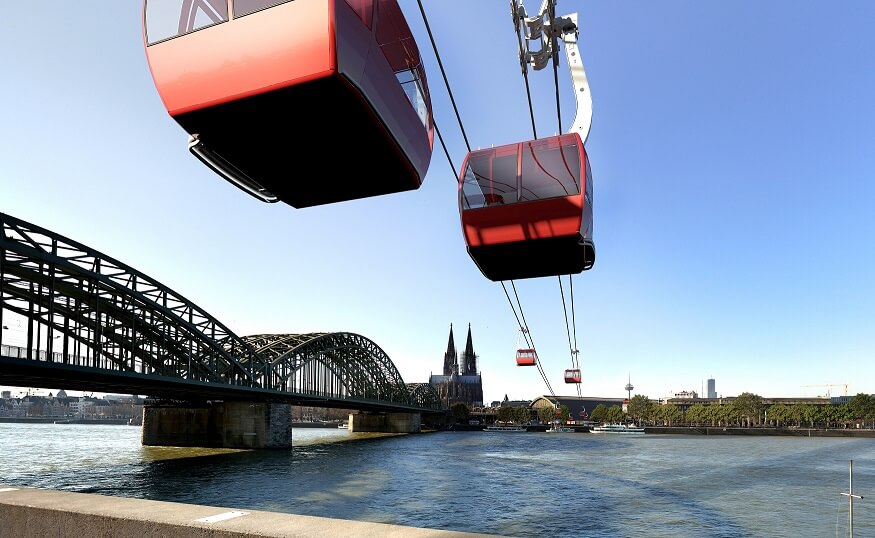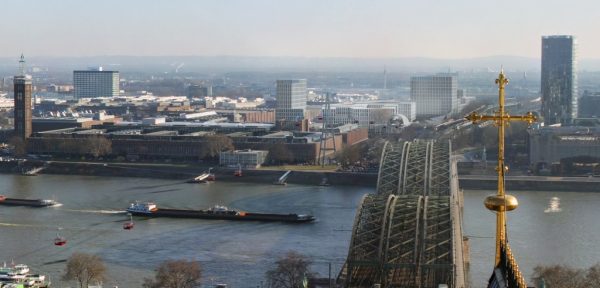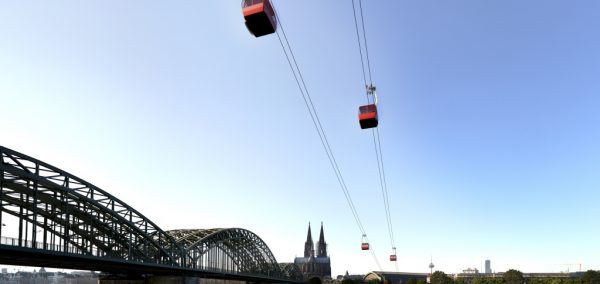
Cities, SI World 2/2019
Cologne: Cable car to connect the exhibition centre to the main railway station
Property company Strabag Real Estate and Cologne exhibition centre specifically want a cable car that connects the main railway station to Deutz station on the exhibition centre site. The reports of various German media concur on this.
Between a minimum of 2,500 and a maximum of 6,000 people per hour will be able to cross the Rhine, which will relieve the strain on the famous Hohenzollern Bridge. Each of the accessible gondolas, which also offer space for pushchairs and wheelchairs, will have space for around 30 to 40 people. As the portal Games Wirtschaft reports, at full capacity, over 70,000 passengers per day could be transported between 8.00 in the morning and 8.00 at night.
10,000 to 15,000 passengers would be realistic. In comparison: On a normal Gamescom trade fair day, there are up to 100,000 people (trade fair visitors, exhibitors, staff, suppliers) on the site. According to the fact sheet from the project manager, which is available to SI Urban, the travel time would be under four minutes.
New district connected
Additionally in the background of the idea is the development of Cologne MesseCity on the Cologne exhibition centre / Deutz railway station site. Office buildings and hotels are being constructed here on an area of 132,000 square metres.
In the medium term, over 5,000 people will live and work here. This alone will inevitably drastically increase the volume of morning and evening commuter traffic, quite apart from trade fair times. At the moment, only S-Bahn suburban railway lines and regional trains run over the Hohenzollern Bridge.
According to the plan of the project participants, the cable car should connect this business district directly to the main railway station and the city centre. The strain on the roads and railways would therefore be greatly eased when visitors and passengers want to travel from the exhibition centre or MesseCity across to the old centre or back. Furthermore, visitors from all over the world would gain a magnificent view of the city.

The cable car will connect two railway stations and districts across the Rhine.
THE OPERATING FRAMEWORK
- Operation Local public transport
network, integration
into the fare system - Capacity At least 2,500
passengers per hour - When Start of construction in
2021, start of operation
in 2022 - Implementation
Eligible for funding
Affordable and acceptable
“A cable car over the Rhine would be significantly quicker and cheaper to implement than an underground railway, for example,” Rainer Maria Schäfer from Strabag Real Estate explains to German broadcaster WDR. “You simply build two masts and two stations, and a cable car like this could be implemented within two years.” Moreover, a cable car is quiet and environmentaly friendly.
One station would be located right next to Deutz railway station and another further to the south of the Musical Dome in line with Trankgasse. “We must avoid crossing private land,” Schäfer says. Otherwise, according to the property contractor in an interview with Cologne review “Kölnische Rundschau”, implementation will be difficult.
He also sees no risk to the world heritage site of Cologne Cathedral as a result of the cable car: “It is acceptable,” Schäfer is sure and points to visualisations. The cable car will be so slender that it will not disturb the view of the cathedral.
He also feels on the safe side here, as former cathedral master builder Barbara Schock-Werner already assured him after the assessment in 2009 that it poses no problem.
The plans provide for a cable car in circulating mode. Photos: Pixel Enlargement 2012 für STRABAG Real Estate

For everyday life – not for tourism
According to the plans, the cable car should be integrated into the local public transport network and primarily not be a tourist attraction. The planned
cable car by the Hohenzollern Bridge is not comparable with the existing cable car by the Zoo Bridge, which has been in place since 1957.
The project is modelled on the cable car in Koblenz, which also goes across the Rhine and which connects the Rhine Promenade with the Ehrenbreitstein Fortress; its construction costs were around twelve million euros.
Schäfer and Cologne Exhibition Centre boss Gerald Böse have not put a figure on the investment costs in Cologne. “That would be up to Cologne transport operator Kölner Verkehrsbetriebe (KVB), as the cable car will have to be integrated into the local public transport network. Journeys must be included on the KVB ticket,” Böse tells the Express newspaper.
This is the only way that the project could be financed from state grants. However, the name for the new cable car already seems to be clear: “Skytrain would be a good title,” the Exhibition Centre boss says.
Before that though, the city, politicians and Kölner Verkehrsbetriebe must first approve the plans – it is unclear how long. ts







